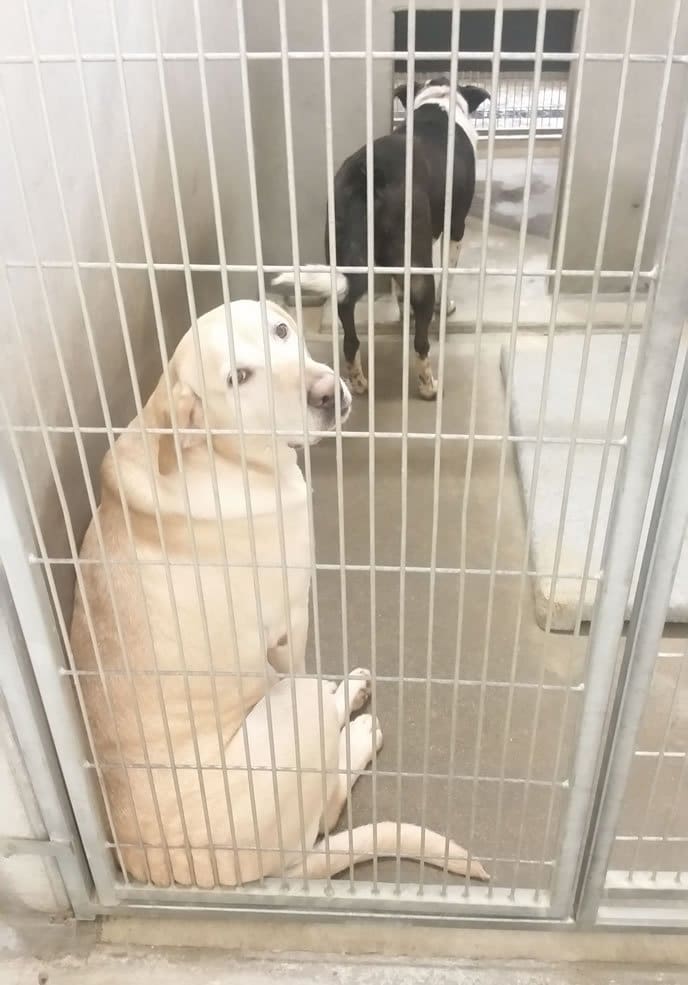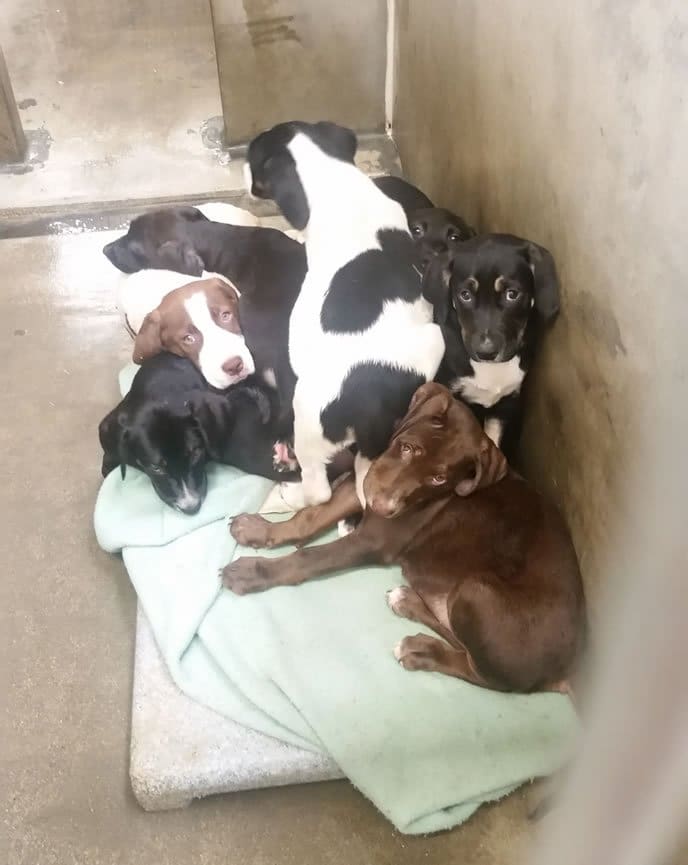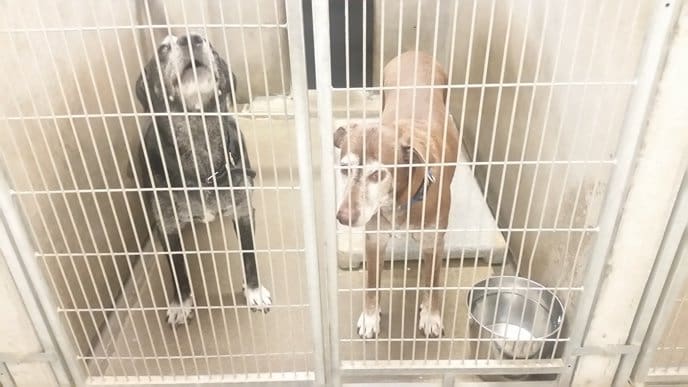
Many of us “feel sorry for the animals” when we visit a shelter’s adoption row and look upon the faces of the dogs who desperately need homes. But those are the lucky ones – the ones who have been assessed and deemed “adoptable.” There are many other dogs in shelters who may not be so fortunate.
Last week, when volunteering at my local shelter, I did something I haven’t done before: I spent most of my time on the “isolation” side of the shelter, rather than with the dogs who were on the “adoption” side.
This experience may not be available to any volunteer at any shelter; shelter managers have to be pretty comfortable that a volunteer can stay out of harm’s way (there are dangerous dogs in quarantine, in addition to stray animals who have not yet been behaviorally assessed by any staff). Anyone who walks through this area must also understand the shelter’s cleaning and disinfecting routine and pattern (so as not to track themselves or dogs across or through a disinfected or not-yet cleaned areas). They also have to be a help, not a hindrance, to the hard work that is going on back there: cleaning the far more crowded part of the shelter, taking care of sick and injured animals, and even euthanizing animals who are profoundly suffering. To be perfectly clear: Parking oneself in front of the kennel containing the most unfortunate dog in the shelter and sniffling helps no one.
In many shelters, the areas that are not open to the public are a bit like a MASH unit, where harried workers are triaging any number of cases that are so sad, it could depress a civilian for a week: the white-faced, arthritic, confused senior dogs who are being held in hopes that their elderly owner manages to recover and return home from the hospital; the extremely fearful dog whose homeless and mentally ill owner was arrested, held, released, and whose whereabouts are now unknown; the mama dogs who were surrendered by their owners when hugely pregnant (or often, while in labor), and are attempting to care for their puppies in the loud, crowded shelter; dogs with mange so severe that they have no hair, and all their skin is red and bleeding from the dog’s near constant scratching and biting, in a vain effort to relieve the incessant itching; the fat, tiny lap dogs who somehow got out of their homes and got picked up by animal control and who have obviously never been kenneled before, but whose owners haven’t thought to or bothered to look for them in the shelter – these dogs are often either completely hysterical or almost completely shut down with depression. There are dogs who were the victims of cruelty – starved and/or beaten or tortured – and are being held as evidence until their owners’ cases are heard; dogs who have been seized by animal control after an attack on another dog or person or animal who are so defensively aggressive that they have no hope whatsoever of being released; embarrassed-looking family dogs who are being quarantined after biting someone; dogs whose owners “just can’t keep them anymore” for any number of reasons – and, of course, mixed in with all of these sad cases, lots of just regular dogs who were brought in as lost or stray.
I’ve been volunteering at my local shelter for long enough that I’m trusted to go “in the back,” though I usually only do so for a specific purpose, and just for a minute – to take out a dog that the staff has asked me for help with, for example. Right now my shelter is understaffed, and so the other day I helped with some of the behavioral triage: identifying some of the best candidates for an immediate move to the adoption wing: nice dogs who have been in the shelter well past the point that a motivated owner may be looking for them. In California, the law states that unclaimed stray dogs can be adopted out or euthanized after they have been in custody for four business days, but my shelter routinely holds dogs much longer, since (in their experience) many owners take far longer to think of or manage to get to the shelter to look for their lost dogs, or to raise the “bail money” they think they might need to get their dogs. (My shelter also routinely makes deals with people who honestly don’t have the money to pay the fees and fines that their dogs may have incurred in getting picked up as strays, especially if the owner has a good plan to prevent the dog from going stray again.)
My day “in the back” was an eye-opener for many reasons, but I’m going to talk about just one right now: the number of “stray” dogs housed in the shelter whose owners had been identified, but whose fates were in limbo for some reason or another, and dogs who were “surrendered” by their owners.
I saw at least a dozen dogs whose cage cards indicate that their owners have been identified, but the dogs were still there because:

– Owner was in the hospital, no relative available to take dog
– Owner in custody (law enforcement); no relative available to take dog
– Owner wasn’t sure he/she could raise any money for fees and fines (owner was encouraged to come to the shelter to discuss a payment plan or “deal,” but hadn’t yet come in)
– Messages left at last known number for the owner, no response
– Owner told staff that the dog had escaped so many times that they just couldn’t deal with the dog any more
– Person at owner’s last known contact number told staff they don’t know where owner is, and they themselves can’t or won’t take the dog
– Person at owner’s last known contact number told staff that the owner “moved and doesn’t want the dog”
– Owner apprised that the dog needs medical attention; owner told staff to “just put the dog down,” but when asked, if care could be provided without cost, would the owner want the dog back, responded, “Maybe…”

Then there are the dogs whose owners brought them to the shelter and surrendered them, because:
– “Moving, can’t keep”
– “Accidental” litter of puppies who are too young or too sick to be put up for adoption immediately
– The dog isn’t good with their kids (or cat, or other dog, or the neighbors’ livestock; there are at least one of each in the shelter kennels at any given time)
– Owner couldn’t afford medical care needed by the dog
I know many dog-loving people who say that if they won the lottery, they’d open a shelter or rescue. My newest lottery wish would be to fund a new position at the shelter: a counselor/trainer/problem-solver, who could go meet with owners and try to help them solve whatever problems are preventing them from keeping (or regaining) their dogs. Do they need help with their fencing? Assistance with paying or negotiating a vet bill? Some training advice and tutelage? Dog food? Medicine? My dream employee would be an expert at connecting the owner with the resources needed to solve these problems.
Back in the real world, though… Many of us have a shallow conception of shelters as being full of “just” lost or stray dogs. After spending a day reading the cage card of every one of the 90 or so dogs in my local shelter right now, I’d estimate that at least a third to a half were either surrendered by their owners, or belong to people who can’t or won’t do what they need to do to recover their pets – and that’s a hard truth to accept. As my husband commented, trying to inject some small humor after listening to me recap my day “in the back” of the shelter, “These are not WDJ subscribers, I take it.” Well, I doubt it; people who have been fortunate enough to have the technology, education, and motivation to subscribe to WDJ or follow this blog are unlikely to be the type of owner who would allow their dog to end up in a shelter limbo. This experience makes me even more grateful for owners like you, and more sympathetic to dedicated shelter employees and volunteers than ever – not to mention, tempted to buy a lottery ticket tonight.







